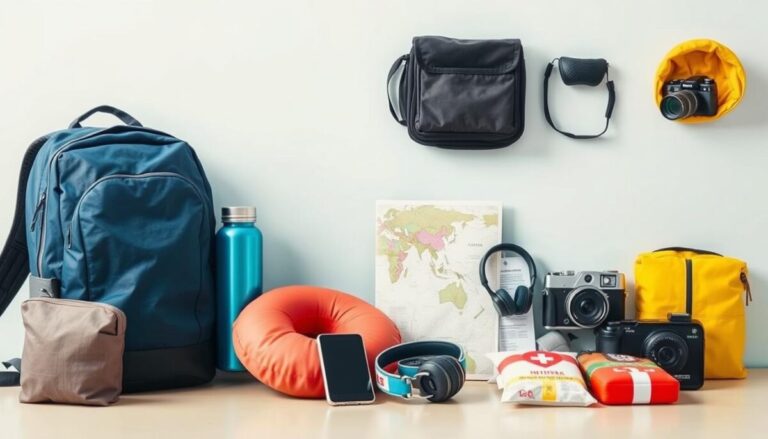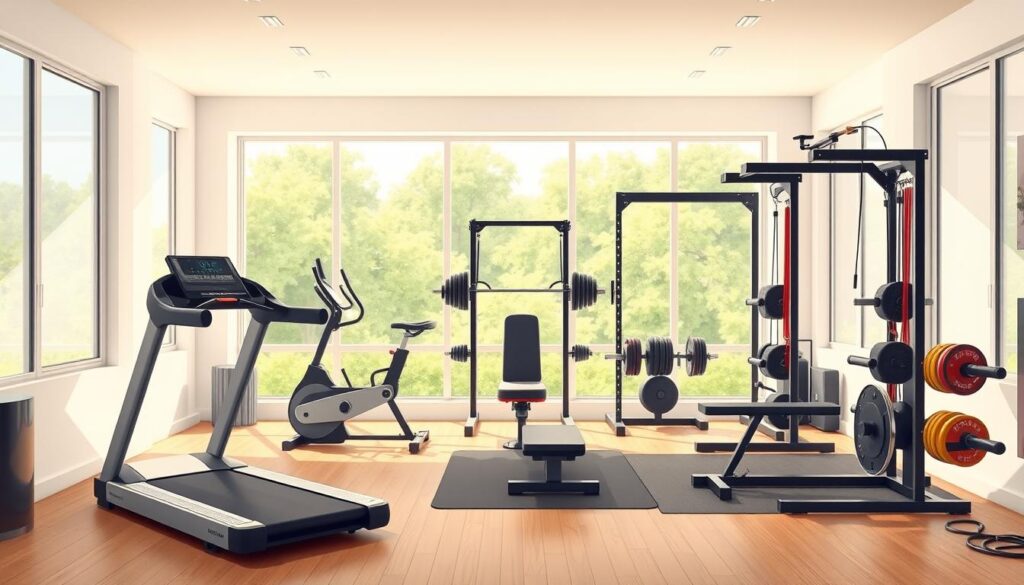
Finding the right fitness equipment can be tough, with so many choices out there. To reach your workout goals, picking the best fitness equipment that fits your needs is key.
First, know what you need for your workout plan. Whether you’re just starting or have been working out for years, the right gear can make a big difference. It helps you reach your fitness goals faster and more effectively.
Key Takeaways
- Identify your workout goals and preferences.
- Consider your fitness level and needs.
- Research different types of fitness equipment.
- Read reviews and consult with experts.
- Invest in equipment that is durable and versatile.
Understanding Your Fitness Goals and Needs
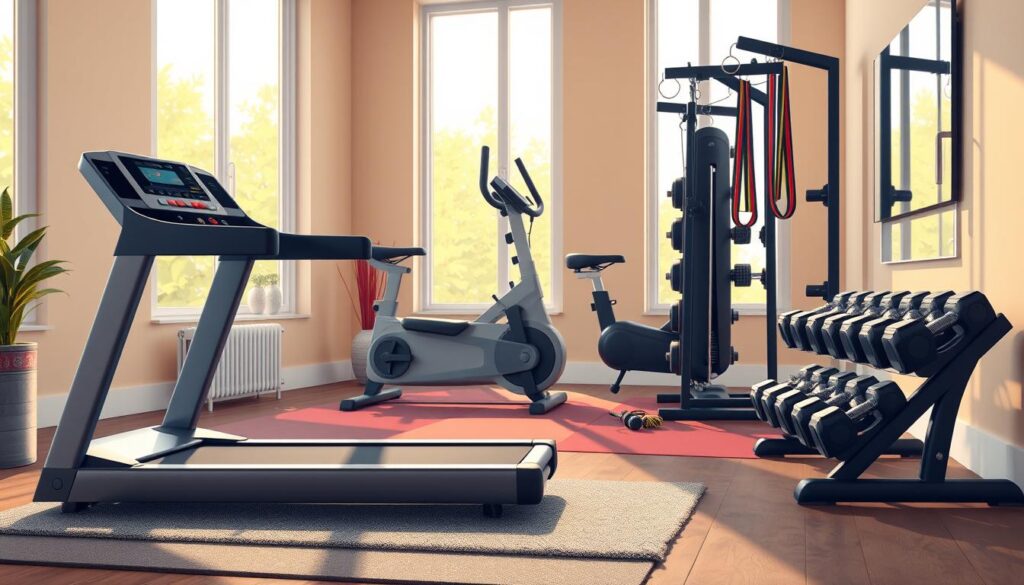
Before buying home gym equipment, define your fitness goals. Knowing what you want will help you pick the right gear. This ensures your workouts are effective.
Identifying Your Primary Fitness Objectives
First, figure out your main fitness goals. Do you want to lose weight, gain muscle, or improve overall fitness? Your goals will guide your equipment choice. For example, if you’re trying to lose weight, you might need a treadmill or elliptical.
Assessing Your Current Fitness Level
It’s important to know your current fitness level. Look at your cardiovascular health, strength, and flexibility. This helps you choose the right equipment for you. It also lowers injury risk and boosts workout effectiveness.
| Fitness Level | Recommended Equipment | Example Workouts |
|---|---|---|
| Beginner | Resistance bands, light dumbbells | Bodyweight exercises, light cardio |
| Intermediate | Treadmill, elliptical, moderate weights | Cardio sessions, strength training |
| Advanced | Heavy weights, high-intensity cardio equipment | High-intensity interval training (HIIT), strength training |
Matching Equipment to Your Exercise Preferences
Your favorite exercises are key in choosing equipment. If you love running, a treadmill is a great choice. For low-impact workouts, consider an elliptical or stationary bike.
By understanding your fitness goals and needs, you can set up a home gym that fits you. This makes your workouts more fun and effective.
Evaluating Your Available Space
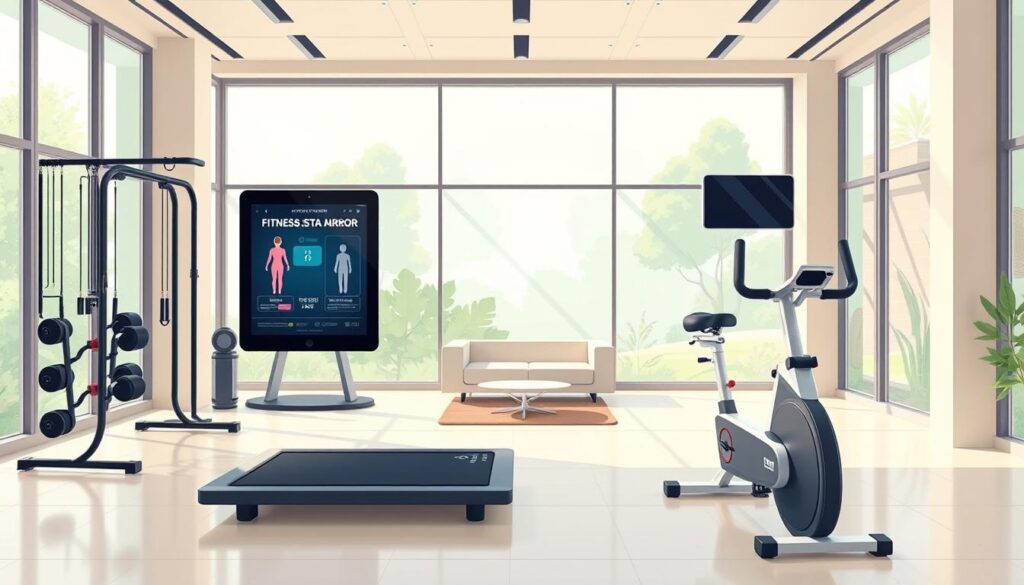
Before you buy the best fitness gear for 2025, measure your workout space. This is key to making sure your gear fits well and works right in your home gym.
Measuring Your Workout Area Dimensions
First, measure the length, width, and any obstacles in your workout area. Think about the door swing, window placement, and heating or cooling vents. Getting the right measurements helps you pick the right equipment for your space.
Equipment Footprint and Ceiling Height Requirements
Different fitness gear needs different amounts of space. For instance, treadmills take up more room than ellipticals or exercise bikes. Also, check the ceiling height if you’re getting equipment like suspension trainers or adjustable dumbbells that need vertical space.
Space-Saving Solutions for Limited Areas
If you have limited space, there are smart solutions. Folding treadmills, wall-mounted gear, and compact ellipticals are good choices. You can also look into multi-functional equipment that does more than one thing.
| Equipment Type | Average Footprint | Ceiling Height Requirement |
|---|---|---|
| Treadmill | 6′ x 3′ | Minimal |
| Elliptical | 5′ x 2.5′ | Minimal |
| Suspension Trainer | 2′ x 2′ | 8′ or more |
Knowing your space limits and what different gear needs helps you make smart choices. This way, you can set up an effective home gym.
Setting a Realistic Budget for Fitness Equipment
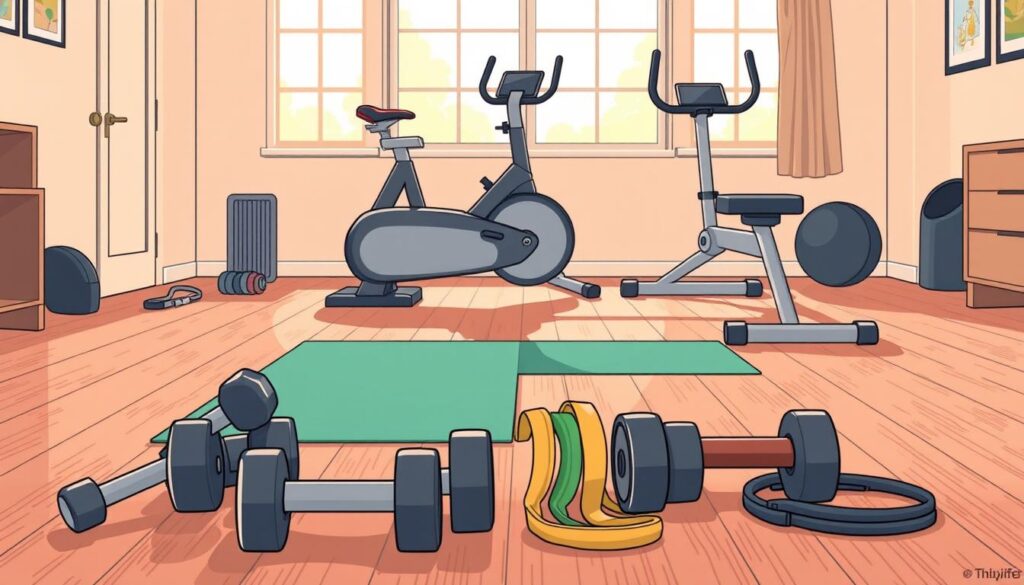
Choosing the right fitness equipment starts with a realistic budget. Your budget will guide your choices. It helps you focus on what you need based on your fitness goals.
Entry-Level vs. Premium Equipment Price Points
Knowing the price range for fitness gear is key. Entry-level items like resistance bands or jump ropes start at about $100. Premium gear, with more features and durability, can cost hundreds to thousands of dollars.
A basic treadmill might cost $500-$1000. But, a high-end model with extra features like incline and virtual training can be over $3000.
Long-Term Value and Cost-Per-Use Analysis
Think about how often you’ll use the equipment and its lifespan. A cost-per-use analysis can show if a pricier item is worth it. For example, a $2000 treadmill used daily might be more cost-effective than a $500 one that needs replacing sooner.
| Equipment | Initial Cost | Expected Lifespan | Cost-Per-Use (Daily Use) |
|---|---|---|---|
| Treadmill (Basic) | $500 | 5 years | $0.27 per day |
| Treadmill (Premium) | $2000 | 10 years | $0.55 per day |
When to Invest More and Where to Save
Investing in quality gear that fits your main fitness goals is important. For example, if you focus on cardio, a good treadmill or elliptical might be worth it. You can save on accessories or less important items.
By carefully planning your budget and spending, you can build a home gym that fits your needs without overspending.
Essential Fitness Equipment for Cardiovascular Training
To boost your cardiovascular workout, pick the right fitness gear. Cardio training is key for heart health, endurance, and calorie burn.
Treadmill Selection: Motor Power, Deck Size, and Features
When picking a treadmill, look at the motor power, deck size, and extra features. A strong motor handles tough workouts. A bigger deck means a more comfy run.
Ellipticals and Cross-Trainers: Stride Length and Resistance Systems
Ellipticals are a low-impact choice instead of running. Check the stride length and resistance systems. A longer stride feels more natural, and adjustable resistance lets you set the intensity.
Exercise Bikes: Upright, Recumbent, and Spin Options
Exercise bikes are great for cardio. They come in upright, recumbent, and spin styles. Upright bikes offer a classic cycling feel, while recumbent bikes support your back. Spin bikes are perfect for intense interval training.
Rowing Machines and Other Cardio Alternatives
Rowing machines work out your whole body. Other options include stair climbers and jump rope systems. Each offers a unique way to boost your heart health.
| Equipment | Key Features | Benefits |
|---|---|---|
| Treadmill | Motor power, deck size, incline | Improves running endurance, burns calories |
| Elliptical | Stride length, resistance | Low-impact, full-body workout |
| Exercise Bike | Type (upright, recumbent, spin), resistance | Improves leg strength, cardiovascular fitness |
| Rowing Machine | Resistance type, stroke length | Full-body workout, improves cardiovascular fitness |
Knowing the features and benefits of each cardio piece helps you choose the best for your home gym. Whether you’re starting out or are seasoned, the right gear helps you reach your fitness goals.
Strength Training Equipment for Different Fitness Levels
To build muscle and get fit, picking the right equipment is key. Strength training boosts muscle, bone density, and metabolism. It’s a must for any workout plan.
The equipment you need changes with your fitness level and goals. Whether you’re starting out or pushing yourself hard, knowing your options is important. It helps you make a workout plan that works.
Free Weights: Dumbbells, Barbells, and Kettlebell Considerations
Free weights are great for building strength. They include dumbbells, barbells, and kettlebells. Each has its own benefits.
- Dumbbells: Ideal for unilateral training and exercises that require a range of motion.
- Barbells: Perfect for compound exercises like squats, deadlifts, and bench presses, allowing for heavier loads.
- Kettlebells: Great for dynamic movements and exercises that combine strength and cardio.
Weight Machines: Single-Station vs. Multi-Station Systems
Weight machines are good for strength training, great for beginners or those who like a controlled setting.
| Machine Type | Benefits | Ideal For |
|---|---|---|
| Single-Station | Focus on specific muscle groups, easy to use. | Beginners, those targeting specific muscles. |
| Multi-Station | Variety of exercises, space-efficient. | Home gyms, those wanting to vary their workout. |
Resistance Bands and Bodyweight Training Tools
Resistance bands and bodyweight tools are perfect for working out at home. They’re affordable and don’t take up much space.
- Resistance Bands: Lightweight, portable, and great for adding resistance to bodyweight exercises.
- Bodyweight Training Tools: Include pull-up bars, suspension trainers, and other equipment that use your body weight as resistance.
Progressive Overload: Planning for Advancement
Progressive overload is key in strength training. It means slowly increasing weight or reps to challenge muscles and promote growth.
To use progressive overload, you can:
- Increase the weight or resistance you’re using.
- Increase the number of repetitions or sets.
- Decrease rest time between sets.
Choosing the right equipment for your fitness level helps you make a better workout plan. This plan will help you reach your fitness goals.
Building a Complete Home Gym Equipment Setup
Creating a home gym is more than just buying gear. It’s about making a space that motivates you to exercise. You need to think about your fitness goals, the space you have, and your budget.
Essential Equipment for Beginners
Beginners should start with basic, versatile equipment. This includes dumbbells, resistance bands, and a stability ball. These tools allow you to do many exercises, helping you reach your fitness goals.
Space-Efficient Multi-Functional Equipment
If space is limited, look for equipment that does more than one thing. A power rack is great because it’s used for squats, bench presses, and pull-ups. It’s a smart choice for any home gym.
Creating Workout Zones in Your Home
Divide your home gym into different zones for a better workout. You might have a cardio area, a strength training area, and a stretching area. This keeps your workouts organized and focused.
Storage Solutions for Home Gym Equipment
Good storage is key to a tidy home gym. Use storage racks, shelves, and cabinets to keep everything organized and easy to find.
By following these tips, you can build a home gym that fits your needs and helps you reach your fitness goals. Choose equipment that’s durable, versatile, and right for your fitness level.
Choosing Fitness Equipment Based on Specific Goals
Fitness goals are different, and so is the equipment needed. Whether you want to lose weight, build muscle, or boost flexibility, you need the right tools. Knowing your main fitness goals helps pick the best equipment for your workouts.
Equipment for Weight Loss and Fat Burning
For losing weight and burning fat, cardio gear is key. Treadmills, ellipticals, and exercise bikes are great for intense workouts. Rowing machines offer a full-body exercise. Think about the space, budget, and your favorite workout type when choosing.
Muscle Building and Hypertrophy-Focused Equipment
For building muscle, you need strength training gear. Free weights like dumbbells and barbells are versatile and help you get stronger. Weight machines are good for beginners. Resistance bands are perfect for those with little space or who prefer easier workouts.
Flexibility, Mobility, and Recovery Tools
For better flexibility and recovery, use tools like foam rollers, stretching mats, and mobility balls. They help with soreness and improve movement. Adding them to your routine can boost performance and lower injury risk.
Sport-Specific Training Equipment Selection
For athletes, specific sports need special equipment. Cyclists might use spin bikes, while runners prefer treadmills. Knowing your sport’s needs helps pick the right gear.
| Fitness Goal | Recommended Equipment |
|---|---|
| Weight Loss | Treadmill, Elliptical, Exercise Bike |
| Muscle Building | Dumbbells, Barbells, Weight Machines |
| Flexibility & Recovery | Foam Roller, Stretching Mat, Mobility Balls |
Top Fitness Equipment Trends and Innovations for 2025
The year 2025 is bringing a new wave to fitness. Trends are moving towards personalized, connected, and eco-friendly gear. As tech gets better and what people want changes, the fitness world is introducing new solutions. These meet a wide range of needs and tastes.
Smart Connected Equipment and App Integration
Smart tech is a big deal in 2025 for fitness gear. Treadmills, ellipticals, and bikes now connect to fitness apps. This lets users track their progress, join virtual workouts, and get coaching tailored just for them.
Key Features of Smart Fitness Equipment:
- Bluetooth and Wi-Fi for easy data sharing
- Works with top fitness apps and wearables
- Interactive touchscreens for a full workout experience
- Custom workout plans based on your data and goals
Virtual Training and Interactive Workout Platforms
Virtual training is getting more popular. It lets users work out at home with expert guidance. In 2025, expect even more advanced platforms. They’ll use AI, VR, and AR for fun and effective workouts.
Benefits of Virtual Training:
- Flexibility in scheduling workouts
- Access to many workout classes and instructors
- Personal feedback and adjustments based on how you do
Space-Saving Design Innovations
For those with little space, 2025 offers cool, space-saving designs. There are foldable treadmills, wall-mounted bikes, and machines that do many things without taking up much room.
Sustainable and Eco-Friendly Equipment Options
More people want eco-friendly fitness gear. In 2025, makers will use recycled materials, cut waste, and create durable, green equipment.
Here’s a look at some top fitness equipment trends in 2025:
| Trend | Key Features | Benefits |
|---|---|---|
| Smart Connected Equipment | App integration, personalized coaching, interactive screens | Enhanced workout experience, progress tracking, personalized plans |
| Virtual Training Platforms | AI, VR, AR integration, variety of classes | Flexibility, guided instruction, personalized feedback |
| Space-Saving Designs | Foldable, wall-mounted, multi-functional | Space efficiency, versatility, convenience |
| Eco-Friendly Equipment | Recycled materials, reduced waste, durable design | Sustainability, reduced environmental impact, longevity |
Conclusion: Making an Informed Fitness Equipment Investment
Choosing the right fitness equipment for your home gym is a big decision. It depends on your fitness goals, the space you have, and your budget. Knowing what you want to achieve and your current fitness level helps you pick the best equipment.
Think about the exercises you like and how much space you have for working out. Also, consider how much you can spend and the equipment’s long-term value. This will help you find equipment that fits your fitness goals.
The right equipment can make your workouts better and help you reach your goals faster. Whether you need gear for cardio or strength training, picking the right equipment is key to a successful fitness journey.
Looking at the latest trends in fitness equipment can help. Options like smart connected gear and eco-friendly choices can make your home gym both effective and fun.
FAQ
What are the key factors to consider when choosing fitness equipment for my home gym?
How do I determine the right fitness equipment for my specific fitness goals?
What are the best cardio equipment options for a home gym?
How can I optimize my home gym space with the right fitness equipment?
What are the latest trends in fitness equipment for 2025?
How do I choose between entry-level and premium fitness equipment?
What are the essential strength training equipment for different fitness levels?
How can I create a functional home gym with the right storage solutions?
Share :
You Might Also Like






